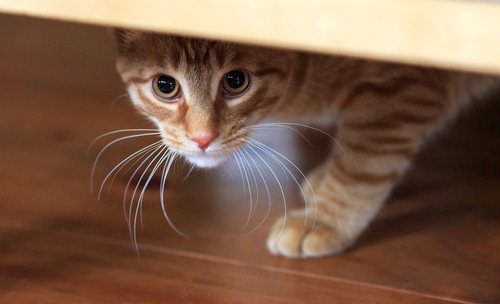How Long for Cat to Adjust to New Home
A new cat or kitten is an exciting time for you or your family. It brings a lot of joy but can also bring a lot of anxiety and stress for everybody if your cat has trouble adjusting to the new environment.
Change is hard for everyone so it's nice to know the process that goes on during a big change like this.
So long does it take for cats to adjust to a new home? Are there things we can do to speed up the process? For most kittens (about 2-6months old), since they're young – they adapt the quickest only needing about 2-3 days to be comfortable in their environment. Adult cats might take some time and could take up to a week before they fully adapt to the environment. With a few preparations and skills – we can cut down the time they need to adjust and begin to create a long-lasting bond with the cats.
In the sections below, we discuss what to do to make the smoothest transition for the cats and a chart to know how long and what to expect for each age group that an individual is most likely to adopt.

Note: this guide assumes that the cats are healthy and have been checked by the vet to make sure there aren't any underlying conditions that might affect their behaviors. This guide also assumes that a cat's necessary items are available: scratching post, litter box, toys, water, etc.
If you're introducing a new cat in a home with multiple cats, I have a full illustrated guide here to make your experience as easy as possible: Cat Introductions With Illustrations!
Room Preparations Before New Cat Arrives for the Smoothest Transition
Before you continue, if you need the ultimate guide on having a cat in a small space or apartment to covers this topic and more: The Wonderful Beginner's Cat Guide!
The environment that any cat gets into plays a huge part in their adjustment time. Having a home or room that's has put in some thought about how a cat might live and move through the room will easily cut down on that adjustment by half or more because their confidence as cats comes from knowing and sensing their environment.
To help with this, in my home (a 30 square meter small apartment), I have developed a list of products that I use to help create a stimulating environment for my cats that save space. Check out the recommended products page!
The next part in room preparations is one of the most important and it is a concept that will get you through this period quickly. It is blocking off the 'unders' of your furniture.
For example, blocking off underneath beds, couches, drawers, and other similar items around the home. It's actually very common advice but no one does it because the reason was relatively weak.

However, the real reason to block off all the 'unders' is so that your cats continuously push their comfort zone in their new environment. A cat that is nervous or timid will take a longer time to explore and adapt to its environment if there's a dark hole to go into.
It may feel safe temporarily for the cat but it generally doesn't let the cat grow into its new space because inside it – the cat has limited knowledge of its environment because of the lack of sights and smells.
With the 'unders' blocked off, they're forced to going to other places – in most cases, these are higher, elevated places that allow them to actually see their environment. Or they are places that the cats can leave their scent and start to create their own zone within the new home.
Chart for Cat Adjustment Length VS Cat Age
These times can vary but in general, these are taken from the stats that I have recorded over time of helping people adopt and introduce cats and introducing cats myself in different environments and homes.
It also takes the type and age of the cat under consideration and provides an approximate adjustment time for each environment that the cat is introduced to.
| Cat Type | Expected Introduction Time (With Environmental Preparations) | Expected Introduction Time (Without Any Environmental Preparations) |
| Most Kittens (Under 6-7 months of age) | 2-3 days | 3-5 days |
| Domestic Adult Cat (1+ Years) | 3-5 days | 5 days-1 week |
| Feral or Stray Cats | 4-7 days | Depending on the cat, up to 1 week+ |
When looking at the stats, the difference between the home or room with the environmental preparations and the place without any environmental preparations is quite drastic.
So even though the preparations might take some effort, it saves a lot of time in the long run – in some cases cutting the introduction time in half.
Feral or stray cats that haven't had proper socialization might take longer as it might be their first time in a home or it's been a long time since they've been taken in.
For this type of cat and situation, it really varies – I've seen cats adapt super quickly and I have also seen some very timid cats who were very distrusting of everything. So for feral cats especially, take it slow and steady.
How to Make a Cat Feel More Comfortable in Its Environment
Now on the first day or two, many owners feel compelled to try every way possible to make the cat more comfortable by touching the cat from the getgo without establishing a line of trust. This can often create unnecessary stress and could prolong the time that the cat needs to adapt.
However, there are a couple of things that we can do without directly physically interacting with the cat and speed up the process.

- Play and Distractions – the longer a cat isn't thinking about its environment, the less it feels threatened by the change. Therefore, even distracting them for a certain amount of time (10-30 minutes) can help with the adapting process.
However, don't put toys in front of their face – let them see the toy moving around in the space and let them stare at it. If they move and try to play with it, even better. But even just focusing on the toy has an effect.
You can use interactive wand tools or laser points to achieve this. Let them follow it for a certain amount of time, then put it away and do it again later.
A cat that is getting more confident with the environment will be more likely to move, swat, and chase at it. Therefore, if you see more and more movement from the cat, that is progress.
- Using Food for Motivation (for more about this: Food Motivation and How You Can Use It as a Great Training Tool) – a hungry cat is a cat that can be trained. Don't let them free feed. If you do still have the 'unders' available, never leave food under the bed. Let the food be a reward for pushing their comfort zone.
If they move or explore a new zone that they've never been to before, give them a treat. It will continue to reinforce that the home is nothing to be threatened by and give them positive associations with you and the area around them.
When feeding snacks, I like to hand feed cats – it begins to create a positive relationship between your hand and the cats. So they learn to trust the hand and this sets them up for the future to begin to be touched, pet, or even held.
In my experience, starting with play and distractions is the best because it is a very hands-off and effective approach without causing any stress. Great for the first day of the cat arriving.
As we wait and observe and they begin to move around and explore, try a little hand-feeding, and see how the cat or kitten reacts. If they eat from your hand then you can progress further next time with hand-feeding + some gentle touching.
Eventually, the cat will get to a point of complete trust with you and its environment.
If you're still having trouble with getting your cat use to its new environment (or with people around him/her), this more detailed guide might help: How to Get Your Cat to Like/Trust You Again.
Signs That Your Cat Is Adjusting
After you've done the necessary preparations and your new cat(s) are in their new home, what are some signs that they might be adjusting well?
Some of the things to look for are:
- They're starting to wander around and sniffing out their new environment. They might walk in and out of their "safe" zone but in general – any sort of exploration behavior or going to new zones is a good signal to know that they're getting more confident in their new space.
- Getting more interested in toys and other stuff around them. They might engage in play with small items or just check the item's reaction.
- More grooming behaviors (for example, starting to lick themselves more). Cat's that feel good will start to keep themselves well-groomed and neat, in comparison, cats that are more stressed out or ill will look a bit disheveled.
- Sleepy or half-closed eyes. Cats that are comfortable in their environment will have "sleepy" eyes. Half-closed eyes show that they're more trusting of their surroundings.
- Expose themselves out in the open. We might see the cat just sprawled out in the middle of the floor. That's another good sign of them being comfortable with their environment.
Other Tools to Help Your New Cat to Adapt to Its New Environment
There are other tools of course and some people have found success with certain pheromones or sprays.
The most popular one being Feliway and it's advertised to help the cats calm down and curb unwanted negative behaviors.
 Feliway 30 Day Starter Kit
Feliway 30 Day Starter Kit
Feliway is a synthetic copy of the feline facial pheromone, used by cats to mark their territory as safe and secure. By mimicking the cat's natural facial pheromones, Feliway creates a state of familiarity and security in the cat's local environment. As a result, Feliway can be used to help comfort and reassure cats while they cope with a challenging situation and help prevent or reduce the stress caused by a change in their environment.
We earn a commission if you click this link and make a purchase at no additional cost to you.
For me, I've faced a situation where I needed it but it's another tool for the job just in case the day comes where the usual methods don't work.

How Long for Cat to Adjust to New Home
Source: https://monsieurtn.com/cat-environment-adjustment/
0 Response to "How Long for Cat to Adjust to New Home"
Post a Comment